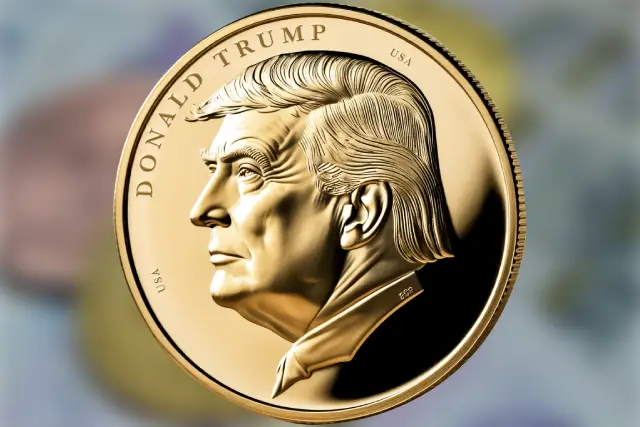The Rise and Fall of “Trump Coin”: A Deep Dive into the Controversial Meme Cryptocurrency
In January 2025, just days before his second inauguration as President of the United States, Donald Trump made headlines by launching a cryptocurrency dubbed “Official Trump” or “$TRUMP.” This venture thrust the former real estate mogul and reality TV star into the volatile world of digital assets, specifically the niche realm of meme coins—cryptocurrencies often born from internet culture, celebrity endorsements, or sheer speculation rather than tangible utility. Since its debut, the Trump Coin has sparked fierce debate, wild price swings, and a flurry of copycats, raising questions about ethics, market speculation, and the intersection of politics and finance. This article explores the origins, mechanics, performance, and implications of the Trump Coin phenomenon as of February 20, 2025.
What is the Trump Coin?
Trump Coin ($TRUMP) is a meme coin launched on the Solana blockchain, a popular platform known for its speed and low transaction costs. Unlike established cryptocurrencies like Bitcoin or Ethereum, which aim to serve as decentralized stores of value or platforms for smart contracts, meme coins typically derive their worth from hype, community enthusiasm, or association with a notable figure or trend. In this case, $TRUMP was marketed as a celebration of Donald Trump’s persona, with its website proclaiming it honors “a leader who doesn’t back down.” The coin’s branding ties directly to Trump’s image, notably referencing his response to a July 2024 assassination attempt with the slogan “FIGHT FIGHT FIGHT.”

The coin debuted on January 17, 2025, with an initial supply of 200 million tokens and a promise to issue a total of 1 billion over three years. Notably, 80% of the supply is held by entities affiliated with the Trump Organization—namely CIC Digital LLC and Fight Fight Fight LLC—while the remaining 20% was made available to the public. This ownership structure, combined with Trump’s high-profile announcement on Truth Social, set the stage for a dramatic entry into the crypto market.
The Explosive Launch and Market Frenzy
The launch of Trump Coin was nothing short of a spectacle. Within hours of Trump’s social media post, the coin’s price skyrocketed from an initial 18 cents to a peak of approximately $75 by January 19, representing a staggering 4,200% surge. At its height, the market capitalization reached nearly $15 billion, briefly making $TRUMP one of the most valuable cryptocurrencies globally. Early traders reaped massive profits—one anonymous wallet reportedly turned a $1 million investment into over $100 million in just two days, according to blockchain analysis.
This meteoric rise was fueled by a combination of Trump’s celebrity status, his vocal support for cryptocurrency during the 2024 campaign, and a broader post-election crypto boom. Bitcoin itself hit a record high above $109,000 around this time, buoyed by optimism over Trump’s pro-crypto stance, including promises to make the U.S. the “crypto capital of the planet.” The timing of the launch, coinciding with a lavish “Crypto Ball” in Washington, D.C., added to the hype, drawing both seasoned traders and newcomers eager to ride the wave.
However, the euphoria was short-lived. On January 19, Melania Trump announced her own meme coin, “$MELANIA,” which siphoned attention and value from $TRUMP, halving its price almost immediately. By Inauguration Day, January 20, $TRUMP had crashed 50% from its peak, and its volatility only intensified in the weeks that followed. As of mid-February 2025, the coin trades around $19—still a significant gain from its starting point but a far cry from its all-time high.
CoinCodex: Projects a potential rise of approximately 229% by March 22, 2025, estimating the price to reach $55.30.
The Mechanics and Controversies of Trump Coin
Tokenomics and Ownership
The structure of Trump Coin has drawn scrutiny from crypto analysts. With 80% of the supply controlled by Trump-affiliated entities, critics argue the coin’s “tokenomics” heavily favor its creators. This concentration allows the Trump Organization to potentially profit billions if they sell their holdings at peak prices, though a three-year unlocking schedule is intended to prevent a sudden “rug pull”—a scam where developers dump their tokens and abandon the project. Trading fees have also been a lucrative revenue stream, with estimates suggesting the Trump family and partners earned nearly $100 million in a single day at the coin’s peak.
Ethical Concerns
The launch of $TRUMP has ignited a firestorm of ethical debate. Critics, including former government ethics officials, label it a blatant conflict of interest. As president, Trump wields significant influence over cryptocurrency regulation, and a personal stake in a digital asset raises fears that policy decisions could be swayed to boost $TRUMP’s value. Legal experts have warned that the coin could serve as a vehicle for influence peddling, with foreign entities or domestic players potentially buying tokens to curry favor with the administration. Norman Eisen, a former Obama administration ethics adviser, called it “the single worst conflict of interest in the modern history of the presidency.”
Adding fuel to the fire, the pseudonymous nature of cryptocurrency transactions makes it difficult to trace who is buying $TRUMP, amplifying concerns about transparency and accountability. Some speculate that early windfalls—such as the $100 million profit by a single trader—could indicate insider knowledge or pre-launch coordination, though no concrete evidence has emerged.
Copycats and Scams
The Trump Coin’s success spawned over 700 imitation tokens, many deposited into the official Trump wallet in an apparent bid to confuse investors or suggest endorsement. Names like “Barron,” “Ivanka,” and even “Elon” (referencing Trump ally Elon Musk) proliferated, alongside blatant scams like “Official Hitler” and “Poo Coin.” This flood of fakes underscores the speculative frenzy and risks inherent in the meme coin space, where novice investors can easily fall prey to deception.
Market Performance and Broader Impact
Boom and Bust
Since its peak, $TRUMP has followed a turbulent trajectory. A February 3 tariffs announcement by Trump—imposing 25% duties on Canada and Mexico and 10% on China—triggered a broader sell-off in risk assets, dragging meme coins like $TRUMP down 15% to $17. Posts on X suggest ongoing volatility, with small buy-ins driving 10-20% gains followed by rapid dumps, possibly by early holders cashing out. Over 810,000 wallets have reportedly lost money on $TRUMP, with collective losses exceeding $2 billion, though these figures exclude trades on some major platforms.
Crypto Industry Reaction
The crypto community is divided. Some enthusiasts hailed $TRUMP as a bold move signaling mainstream adoption, especially given Trump’s campaign promises to ease regulations and create a national Bitcoin reserve. Others see it as a stain on the industry’s credibility, reinforcing perceptions of crypto as a playground for scams and speculation. “Trump needs to fire his crypto advisors,” tweeted Gabor Gurbacs of Pointsville, reflecting frustration among those hoping for a more serious approach to digital assets.
Political and Economic Implications
Trump Coin’s saga intersects with broader economic trends. The tariffs-induced market dip in early February highlighted crypto’s sensitivity to macroeconomic shifts, with meme coins bearing the brunt of investor flight to safety. Meanwhile, Trump’s pro-crypto stance—evidenced by his nomination of industry-friendly figures like Paul Atkins to head the SEC—could reshape the regulatory landscape, potentially legitimizing digital assets or amplifying speculative bubbles.
What’s Next for Trump Coin?
As of February 20, 2025, Trump Coin remains a polarizing experiment. Its value hovers around $19, with a market cap above $5 billion, placing it among the top meme coins but well below Dogecoin’s $53 billion. The planned release of 800 million additional tokens over three years could dilute its price further, though sustained hype or favorable policies might prop it up. For now, it exemplifies the absurdity and allure of meme coins—assets that thrive on narrative rather than utility.
For investors, Trump Coin is a high-stakes gamble. Its ties to a sitting president offer unique intrigue but also unparalleled risks, from regulatory scrutiny to ethical fallout. For the crypto industry, it’s a test case: Will Trump’s involvement bring legitimacy or perpetuate the “wild west” reputation? And for Trump himself, it’s another chapter in a career defined by branding and bold ventures—albeit one that could redefine the boundaries of political and financial power.
Also Read: Jio Coin: Revolutionizing the Blockchain Landscape in India





